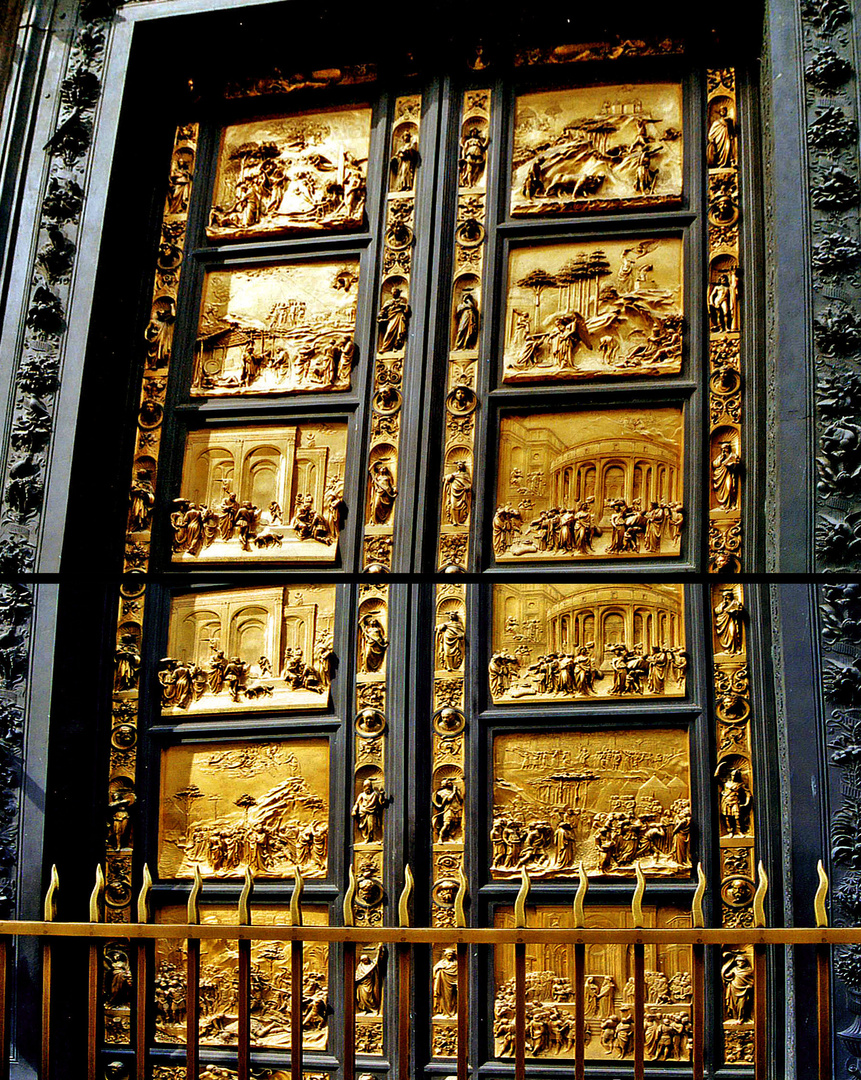Gates of Paradise, Battistero di San Giovanni (Florence Baptistery)
Gates of Paradise, Battistero di San Giovanni (Florence Baptistery)
The Florence Baptistery (Battistero di San Giovanni), also known as the Baptistry of Saint John, is a religious building in Florence, Italy, and has the status of a minor basilica. The octagonal baptistery stands in both the Piazza del Duomo and the Piazza di San Giovanni, across from Florence Cathedral and the Campanile di Giotto. The Baptistery is one of Florence’s most important religious buildings, dedicated to his patron saint, John the Baptist (whose feast is celebrated on 24 June). Raised on the foundations of a Roman building, it is a characteristic example of the Tuscan Romanesque style, dating according to some authorities from around the 11th century (it was consecrated in 1059); others believe that it is an early Christian building later remodelled. Intended for the liturgical function of baptism, in the 11th century it also acted as the city’s Cathedral. Such a large building was required because vast crowds attended the administration of baptism, which in those days took place only twice a year.
Its form is octagonal, and the exterior is sheathed in white marble and green Prato marble. The lower register has semi-pilasters, and the upper one polygonal columns supporting rounded arches. The third order, the roof and the lantern are typical of the 12th century; the west end is closed by a scarsella or altar recess, added in the 13th century. The powerful guild of Calimala (Cloth-Merchants) held the patronage of the Baptistery for centuries, and it was they who commissioned the magnificent gilded bronze doors, as well as many of the works of art inside. The earliest of the three doors is the one on the south side, modelled in 1330 and then cast by Andrea Pisano. It was set up in 1336 on the east side, and moved in 1452 to make way for Lorenzo Ghiberti’s ‘gates of Paradise’. The decoration of Andrea’s door consists of quatrefoil panels of Scenes from the life of St John the Baptist, with the Theological and Cardinal Virtues beneath. When the door was moved to south side it was provided with a bronze frame, made between 1452 and 1462 by Lorenzo Ghiberti’s son Vittorio. Lorenzo himself made the north door between 1403 and 1424, after he had won the famous competition of 1401, in which his submission was preferred to those of Brunelleschi, Jacopo della Quercia and other artists. The north door consists of twenty quatrefoils panels with scenes from the Life of Christ, the Four Evangelists and the Doctors of the Church. This scheme seems to have cramped Ghiberti’s talent for naturalistic representation, which however was given free rein in his great masterpiece, the third Baptistery door. In this one, called by Michelangelo ‘the gates of Paradise’, Ghiberti was able fully to express his gifts as a goldsmith and a sculptor, distributing in ten large panels some of the principal scenes from the Old Testament, from the Labours of Adam and Eve to the Meeting of Solomon and the Queen of Sheba. Commissioned by the Calimala in 1425, it was finally finished and installed in 1452.
The ten panels of the East doors, or Gates of Paradise, by Lorenzo Ghiberti [top to bottom, left to right]:
1. Adam and Eve
2. Cain and Abel
3. The drunkenness of Noah
4. Abraham and Isaac
5. Esau and Jacob
6. Joseph sold into slavery
7. Moses and the ten commandments
8. The fall of Jericho
9. David and Goliath
10. Solomon and the queen of Sheba
Battistero di San Giovanni Ceiling

Battistero di San Giovanni (Florence Baptistery) Ceiling
Amit Banerjee
http://www.museumsinflorence.com/musei/Baptistery_of_florence.html
http://en.wikipedia.org/wiki/Florence_Baptistery










Commentaire 0
Supprimer le commentaire
Effacer commentaire et réponses